6 Best 3D Printer Extruder Hotends
The extruder hotend is one of the most important parts of a 3D printer. It’s responsible for melting the filament and depositing it onto the print bed to form a solid object. In short, a 3D printer won’t be able to do its core function without it.
The hotend counts for one-half of the print head or extruder, with the cold end being the other half. In a direct drive setup, the hotend is positioned directly below the cold end; in a Bowden setup, the hotend is separate from the cold end, which is mounted somewhere on the frame. Size-wise, the hotend is one of the smallest parts of a 3D printer, but it has a big impact on the print quality and material compatibility.
That’s why a lot of users invest in a hotend upgrade. It’s safe to assume that you’re in the market for one as well, which is the reason you’re reading this guide to the best 3D printer extruder hotends. Considering the number of options on the table, it can be difficult to find a hotend that best suits your needs, not to mention one that will hold up for more than just a few months.
We’re here to help you shop for the best hotends on the market. No need to spend a significant amount of time going through dozens of products at online stores, which are filled with cheap clones. We already did that for you. The products included here are the best hotends you can get today, and that includes the extremely popular E3D V6 hotend. Here’s a quick look at the items you’ll find on this list:
| Budget |
|---|
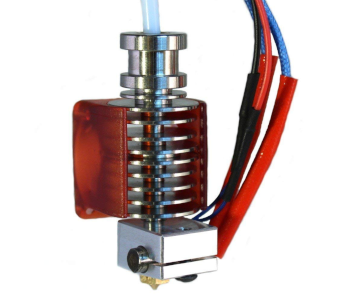 |
| E3D Lite6 |
| 4.2/5.0 |
| Filament Size Options: 1.75 mm |
| Default Nozzle Options: 0.4 mm |
| Fairly easy to assemble. Compatible with the E3D ecosystem. |
| Check Amazon |
| Best Value |
|---|
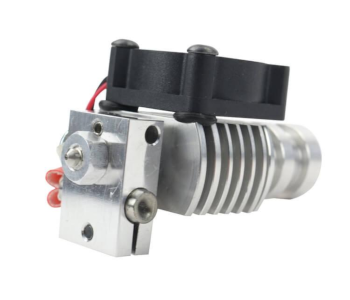 |
| Prometheus V2 |
| 4.4/5.0 |
| Filament Size Options: 1.75 mm, 3 mm |
| Default Nozzle Options: 0.3 mm |
| Durable all-metal construction with a steel nozzle. |
| Check Amazon |
| Top Pick |
|---|
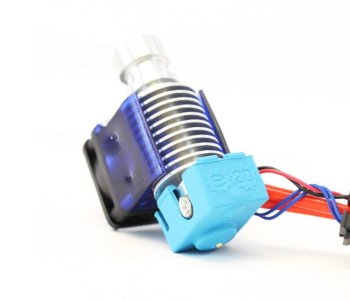 |
| E3D V6 |
| 4.5/5.0 |
| Filament Size Options: 1.75 mm, 3 mm |
| Default Nozzle Options: 0.4 mm |
| Compatible with almost all FFF/FDM 3D printers. |
| Check Amazon |
Structure and Function of the Hotend
The extruder hotend is not just one component. It’s actually made up of several parts — namely the heater cartridge, the thermistor, the nozzle, the heater block, and the heat break. Some people only consider the former three as the main components, though. The heat sink is also considered a part of the hotend.
The heater cartridge heats up the filament while the thermistor is the dedicated sensor for the hotend temperature. The nozzle is the tip of the extruder setup and has a small opening where the melted filament comes out. The heater block connects the nozzle to the heat break and holds the heater cartridge and thermistor while the heat break connects the heater block to the heat sink, serving as the bridge between the cold end and the hotend.
The nozzle comes in different sizes, with the standard being 0.4 millimeters. The nozzle size has a direct effect on the overall print quality and print speed. A smaller nozzle can produce more detailed 3D models while a larger nozzle can print at a much faster rate. The good news is that you can easily swap out the nozzle for a different one, allowing you to adjust your setup based on your target output.
In addition to the print quality and speed, the hotend also affects the materials you can use. There are different types of filaments, and some of them can only be printed with an all-metal hotend, which can handle extremely high temperatures. Of course, going for an all-metal hotend doesn’t mean you get instant access to the most advanced and most exotic materials on the market. There are also other factors that affect material compatibility – like the print bed type.
On a related note, the overall extrusion performance of your 3D printer doesn’t depend entirely on the quality of the hotend. As mentioned in the introduction, the extruder also has a cold end, which is responsible for pulling and clamping the filament and pushing it toward the hotend. If you want to get the most out of your top-class hotend, you should pair it with an equally capable cold end. The E3D Titan and the Bondtech QR are examples of highly capable extruders that offer a lot of value.
Hotend Buyer’s Guide
There are different hotend designs. Some hotends are modular in design, allowing you to easily change the components. Others have an all-in-one design in which the nozzle, the heater block, and the heat break are just one component. When it comes to supported 3D printers, some hotends can be mounted on almost any model currently out on the market while others can only be mounted on specific models.
When shopping for the best extruder hotends, it’s important to keep an eye on the compatible filament size of the product. If the hotend is designed for 1.75-millimeter filaments, don’t even think about buying it as an upgrade for a 3D printer equipped with a cold end that uses 3-millimeter filaments, and vice versa. If the cold end and the hotend don’t match with regard to the filament size, you’ll just end up with failed prints.
Aside from the filament size, you also have to consider the voltage and whether or not the hotend has an all-metal construction. Hotends are available in either 12V or 24V, with the former being the default rating for many products on the market. Make sure the hotend you choose is in line with the power configuration of your 3D printer, for safety purposes.
As previously mentioned, some filaments can only be printed with an all-metal hotend. If you plan to print with materials that require high temperatures, such as Nylon and TPU, go for a hotend with an all-metal construction. If, however, you only print with standard filaments and have no plans to try more advanced ones in the future, then a PTFE/PEEK hotend — which is not designed for temperatures way north of 250 degrees Celsius – should be good enough for your setup.
One last thing to be mindful of when shopping for the best hotends is the sheer number of cheap clones out on the market. Seriously, there are dozens of them, the majority of which are not worth your money, much less a second look. If you can’t afford to spend more than $20 on a new hotend, it’s best to save up and wait until you have enough funds to buy a high-quality product.
3D Printer Extruder Hotends Comparison Table
| Make and Model | Rating | Filament Size Options | Default Nozzle Options | Printable Materials | Price |
|---|---|---|---|---|---|
| E3D V6 | 4.5 | 1.75 mm, 3 mm | 0.4 mm | ABS, PLA, Nylon, and others | Check Price |
| E3D Lite6 | 4.2 | 1.75 mm | 0.4 mm | ABS, PLA | Check Price |
| DisTech Automation Prometheus V2 | 4.4 | 1.75 mm, 3 mm | 0.3 mm, 0.4 mm, 0.6 mm, 1 mm | ABS, PLA, TPU, and others | Check Price |
| Micro Swiss MK10 All-Metal | 3.9 | 1.75 mm | 0.2 mm, 0.3 mm, 0.4 mm, 0.5 mm, 0.6 mm, 0.8 mm, 1 mm, 1.2 mm | ABS, PLA, PETG, and others | Check Price |
| RepRapDiscount Hexagon | 4.0 | 1.75 mm, 3 mm | 0.4 mm | ABS, PLA, HIPS, and others | Check Price |
| Genuine J-Head 10 | 4.3 | 1.75 mm | 0.35 mm, 0.4 mm, 0.5 mm, 0.6 mm, 0.8 mm | ABS, PLA, PETG, and others | Check Price |
1. Best Pick: E3D V6
Editor’s Rating: 4.5/5
The E3D V6 is the gold standard. It’s considered the best hotend that you can get right now. The V6 is a customizable all-metal hotend built for high-temperature performance, making it an ideal hotend for advanced and exotic materials. It has a compact and modular design, with full compatibility with the entire E3D ecosystem, allowing you to easily change some of the components.
The V6 comes in a kit, which means you need to assemble it on your own. E3D offers multiple configurations for the product, including the option to get just the metal components instead of the full kit. The filament size, the filament input (direct drive or Bowden), and the voltage are all customizable, giving you the chance to get the hotend that fits perfectly with your 3D printer setup. For an extra cost, you can also get a pre-assembled package as well as additional nozzles.
If you want the best and safest pick, go for the V6. It’s easy to clean, comes with a large community that you can turn to for troubleshooting, and produces excellent results. Best of all, it can be mounted on almost any FFF/FDM 3D printer out on the market.
| Tech Specs |
|---|
| Filament: 1.75 mm, 3 mm |
| Nozzle: 0.4 mm |
| Material: ABS, PLA, Nylon, and others |
| The Pros |
|---|
| Compact and lightweight design |
| Customizable setup |
| Easy maintenance |
| Lots of online support |
| Compatible with almost all FFF/FDM 3D printers |
| The Cons |
|---|
| Noisy cooling fan |
| Slightly difficult kit assembly |
2. Best Budget: E3D Lite6
Editor’s Rating: 4.2/5
The Lite6 is a more affordable hotend from E3D, offering a more limited capability and fewer package customization options. Instead of an all-metal construction, it has a mostly metal construction with a PTFE liner, which means it has a stricter temperature limit.
While the E3D V6 is designed for intermediate and advanced users, the Lite6 is meant for beginners. It’s relatively easier to assemble and mount on a 3D printer. It’s also compatible with the entire E3D ecosystem, which means you can replace some of the parts. Since the Lite6 is not meant for high-temperature prints, you’re pretty much limited to standard materials like ABS and PLA.
If you don’t really need an all-metal hotend, the Lite6 is one of the best low-cost extruder hotends you can get right now. It’s reliable and easy to maintain and has a lightweight and sturdy construction. It’s limited to 1.75-millimeter filaments, though, so skip it if you mainly use 3-millimeter filaments.
| Tech Specs |
|---|
| Filament: 1.75 mm |
| Nozzle: 0.4 mm |
| Material: ABS, PLA |
| The Pros |
|---|
| Budget-friendly price |
| Fairly easy to assemble |
| Compatible with the E3D ecosystem |
| Prints really well with ABS and PLA |
| Compatible with almost all FFF/FDM 3D printers |
| The Cons |
|---|
| Limited to standard filaments |
| Strict temperature limit |
3. Best Value: DisTech Automation Prometheus V2
Editor’s Rating: 4.4/5
The DisTech Automation Prometheus V2 is a highly capable hotend machined from a single piece of stainless steel. It’s an all-metal hotend that sells for about $80, with the option to choose a filament size. It comes in a kit, which means you need to put it together. The assembly is slightly more forgiving to 3D printing beginners compared to the E3D V6 — but not as simple as with the E3D Lite6.
A compact and lightweight hotend, the Prometheus V2 is a reliable and efficient hotend with a stainless steel nozzle, easily separating it from most hotends on the market (which often come with brass nozzles). It can be used on either a direct or a Bowden setup, although the kit does not include the complete set of components required for a Bowden setup.
The Prometheus V2 can easily handle all sorts of filaments, including the more advanced ones. It’s compatible with almost any FFF/FDM 3D printer on the market and comes with excellent customer support. If you can afford to spend around $80 on an extruder hotend, the Prometheus V2 is one of the best options on the table.
| Tech Specs |
|---|
| Filament: 1.75 mm, 3 mm |
| Nozzle: 0.3 mm, 0.4 mm, 0.6 mm, 1 mm |
| Material: ABS, PLA, TPU, and others |
| The Pros |
|---|
| Compact design |
| Durable all-metal construction with a steel nozzle |
| Can be used on a Bowden setup |
| Compatible with almost all FFF/FDM 3D printers |
| Great customer support |
| The Cons |
|---|
| Expensive |
| Relatively small community |
4. Micro Swiss MK10 All-Metal
Editor’s Rating: 3.9/5
Micro Swiss offers a good selection of all-metal hotends for some of the best 3D printers under $1,000, including the FlashForge Creator Pro and the Creality CR-10. The Micro Swiss MK10 All-Metal is an upgrade for the stock hotend of the Qidi Tech I, the Monoprice Maker Select v2, the FlashForge Dreamer, and other 3D printers.
It’s easy to mount on the extruder. But unlike the popular E3D V6, this Micro Swiss hotend doesn’t come with the complete package. The only components included in the box are the brass nozzle, the thermal tube, and the thermal grease. It’s worth noting that the thermal tube is made up of two different materials: the lower part is stainless steel while the upper part is aluminum.
If you own a 3D printer with an MK10-style extruder, consider upgrading to the MK10 All-Metal. It’s a well-constructed hotend built for high temperatures. Micro Swiss offers different nozzles sizes for the product, allowing you to get a 0.2-millimeter nozzle for high-resolution prints such as 3D-printing miniatures.
| Tech Specs |
|---|
| Filament: 1.75 mm |
| Nozzle: 0.2 mm, 0.3 mm, 0.4 mm, 0.5 mm, 0.6 mm, 0.8 mm, 1 mm, 1.2 mm |
| Material: ABS, PLA, PETG, and others |
| The Pros |
|---|
| Easy to mount on all compatible extruders |
| All-metal construction |
| Multiple nozzle options |
| The Cons |
|---|
| Not a full kit |
| Limited 3D printer compatibility |
5. RepRapDiscount Hexagon
Editor’s Rating: 4/5
The RepRapDiscount Hexagon is another capable all-metal hotend that you can count on to deliver great results when printing with different filaments. It’s an actively cooled hotend that fits with most extruders and can easily handle high temperatures up to 300 degrees Celsius.
Unlike the Micro Swiss MK10 All-Metal, the Hexagon comes with a more complete package. The full kit, which sells for around $70 when ordered from its US supplier, includes a nozzle, a heater cartridge, a thermistor, and a heater block, among others. It has filament size options and fits on most extruders.
While not as customizable as the E3D V6 and the DisTech Automation Prometheus V2, the Hexagon is still a good all-metal extruder hotend that can get the job done in a reliable manner. It prints well with high-temperature materials and has a compact design. It could use a bit more documentation, though, especially with regard to the assembly.
| Tech Specs |
|---|
| Filament: 1.75 mm, 3 mm |
| Nozzle: 0.4 mm |
| Material: ABS, PLA, HIPS, and others |
| The Pros |
|---|
| Prints well in high temperatures |
| Good construction |
| Compatible with most extruders |
| Full kit |
| The Cons |
|---|
| Lacks proper documentation |
| Not as customizable as other hotends |
6. Genuine J-Head 10
Editor’s Rating: 4.3/5
The Genuine J-Head 10 is a recommended hotend upgrade for those who mainly print with PLA and don’t bother with more advanced filaments. It’s an excellent hotend designed for 1.75-millimeter filaments. If you print with 3-millimeter filaments, consider the Genuine J-Head Mk V-BV instead, which is slightly cheaper.
Constructed with high-quality parts, the J-Head 10 is a compact hotend that easily mounts on most compatible extruders and has options for the voltage, the filament input, and the nozzle size. It has a maximum operating temperature of 248 degrees Celsius, which means it is not the most ideal hotend for advanced materials that require extremely high temperatures.
The J-Head 10 is one of the most reliable hotends on the market. It has a long history and has gone through multiple revisions over the years. Unlike most of the other products included in this guide to the best 3D printer extruder hotends, the J-Head 10 is assembled out of the box, although you still need to attach the electronics to the unit.
| Tech Specs |
|---|
| Filament: 1.75 mm |
| Nozzle: 0.35 mm, 0.4 mm, 0.5 mm, 0.6 mm, 0.8 mm |
| Material: ABS, PLA, PETG, and others |
| The Pros |
|---|
| Simple and compact design |
| Prints extremely well with PLA |
| Easy to mount on extruders |
| Good documentation |
| The Cons |
|---|
| Not ideal for extreme temperatures |
Contents

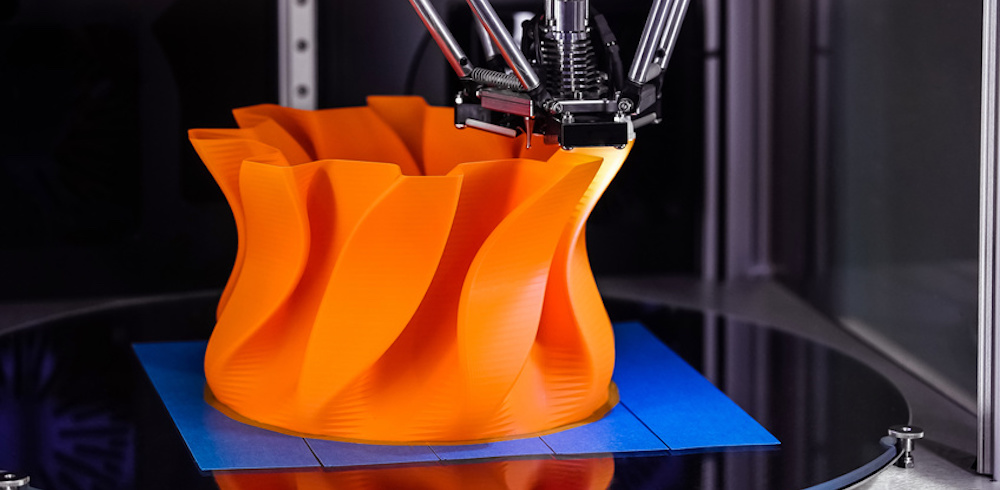

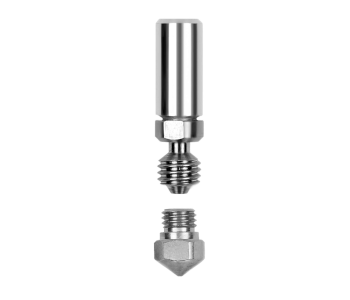 View on Amazon
View on Amazon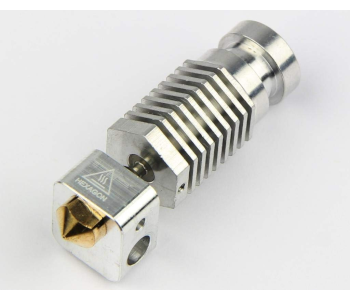 View on Amazon
View on Amazon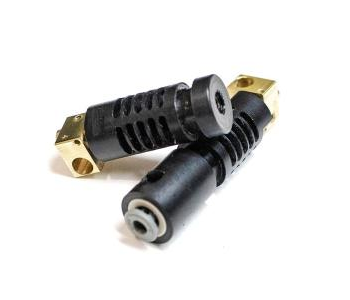 View on Amazon
View on Amazon